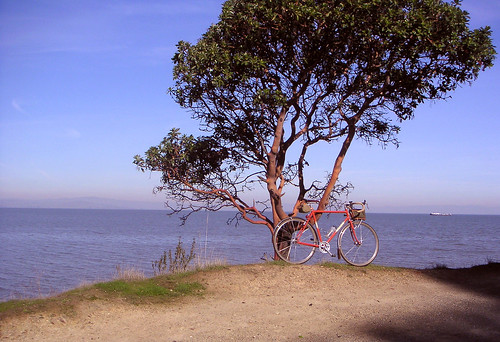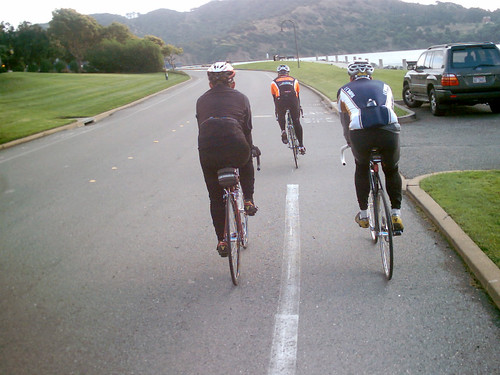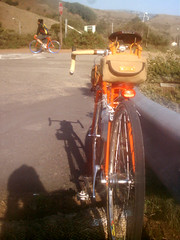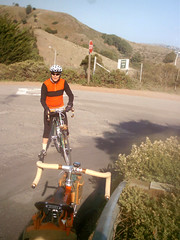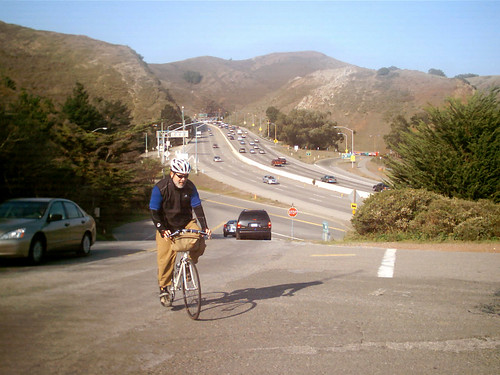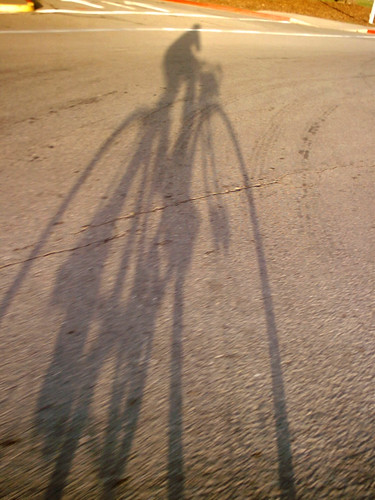Through a fluke of the calendar, very regular commuting, odd days off and weather this last month of the year went pretty well indeed. It also helped that things started with an excellent Fixed-Gear Loop, which notched a goodly chunk o’ miles to start things off. Felt good enough about things by the end of December to mail in my registration for the SFR 200K, for which the Quickbeam is actually seeming like the first choice. Of course, I still haven’t done an inordinate amount of climbing on that bike, and that’ll be the final test before I make the decision.
Snuck in 22 days of riding and nabbed 522 miles this month (high water mark for 2009!), mostly on the Quickbeam, but with a nice mix of Hilsen and Dawes miles as well. With a no-class-on-holidays schedule combined with our teacher having a couple of subs (which we opted out of), only got to yoga 5 times. Definitely feel a little tighter, especially with the increase of mileage.
Total mileage for 2009 - 4132. Happy with that.
Everybody be safe tonight. See ya next year.
Was trying to track down a photo from a couple years ago, and the google machine gave me a link to an old blog post I’d made. I absent-mindedly clicked on it and - poof - I’m realizing that I’m looking directly at my cyclofiend.com blog. This is really only of note to me, as I seem to be the only one who can’t actually access the danged thing (tech details here).
But, since home-access seems to be working for the first time in several weeks. I thought I’d just honor the un-glitch by making a quick post. Now, I need to decide if it is worth actually posting the snippets and notes from the past week or so.
I guess the only one which comes to mind is from last weekend. Rain ride. Fenders on the Quickbeam. Rainlegs and jacket. As I’m starting to working my way north again, at the base of the Camino Alto hill, a vehicle edged up next to me and slowed to match my speed. Driver started hollering something.
Then it sort of registered what he was calling out -
“I love that bike! That’s my favorite bicycle!”
I smiled, thanked him, we chatted a bit and then I waved back and he motored onward. Made for a damned fine ride home.
(Still having bloglogon issues at home, so this is a little tardy of a writeup - sorry for the delay. Perhaps it should be retitled “A Previous Weekend’s Fixed-Gear Get-Together”…)
Although we awoke today (12/7) to snow levels as low as 800′ or thereabouts, and I’m fretting tonight about my lemon tree and cymbidiums dealing with projected sub-freezing temps, it was certainly a fine weekend for riding.
Ron L. had been agitating for a fixed gear ride up in Marin, and since it is my home turf, I was looking forward to the opportunity. He picked last Saturday for the date, and announced it on the RBW group. It hit on a good (i.e. no classes or plans) weekend for me, and a few other list denizens answered in the affirmative as well.
I’d been feeling pretty good in the week leading up to the ride, and planned on honoring momentum if I could get up and out on time. I’d done a little tech tweaking, waxed up my Keven’s bag which had been awaiting it’s first use since I received it as a birthday gift and laid out the riding gear in order.
Things flowed well the next morning, and before I knew it, I’d slipped out the door into a brisk day and headed south to the meeting spot at the Golden Gate Bridge. It was a beautiful time of day to be out, with bright sun for most of the way.
The only mishap was a bloated group ride which forgot to remember that the Mill Valley Bike Path was actually a two-way route. It’s important to remember that just because you are following a few wheels, not to turn off your brain. C’mon kids.. Y’see, if everyone fades slightly out to their left, then you end up spread across the pavement. Yeah. So. Anyway.
Rolled up to the meeting point at the south end of the GGBridge, and when I saw a Quickbeam on a double-legged kickstand, I knew I was in the right place. 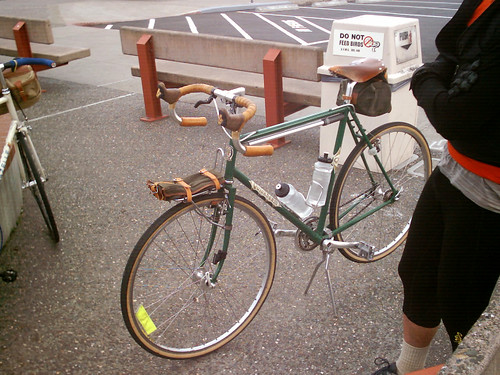
Said hey to Ray, and finally met Jim and Tom in person. Ron pulled up a few minutes later and we coalesced into a moving group. As I’d mentioned, the plan had been for a fixed-gear ride, but none of us was going to kick anyone out who wanted to attend. As it was, Ray was running his Quickbeam in coastable mode, and Mike showed up with a full array of gearing options, as well as one of those chain-bending-shifty things to help him choose between him.
Of course, the fact that Mike was running his multi-geared coastable setup on a repainted FUSO didn’t hurt a bit. That was really a fine looking ride. Actually, every bike on the this adventure was pretty gorgeous. Tom runs a “low-key” Della Santa that is just beautiful to behold, even under the plain-wrap paint choice. The-other-Jim had his Gazelle out for a run, and it has seen some miles, but wore it quite well. Of course, you probably know I’m biased about Quickbeams, and it was nice to have 2/3rds of the stock color spectrum represented. Ron rolled along on his Bilenky, which had a “bent” seat tube and curly chainstays. Between the metal work and the rich paint job, it was a stunner. The last rider (whose name I just totally drew a blank on…) had a Steve Rex track bike, which showed off the stunningly smooth fillet-brazed finish work that Rex is known for.
As we went across the bridge, the sea breezes bit in noticeably, and it was a hunker-down-until-the-warmth-builds-up period to be sure. Unfortunately, as we reached the north tower, the-other-Jim’s chain started acting up a bit. This continued to plague us as we dropped down into Sausalito, and we limped a bit until we decided to lose a link from his setup.
Rule One on a Fixed-Gear Ride: Always have a chain tool and at least 4 extra links to the chain you are running.
Luckily, I did have mine, and since we were shortening rather than replacing a bum link, it went smoothly.
At some point, though, we lost Ray. I mean, we didn’t try to ditch him or anything, but he’d gone ahead on a natural break while we were messing with the chain mid-Sausalito, and I thought he’d rejoined us when we finally paused to let Jim-who-I’m-gonna-hafta-give-an-initial-to flip into coastable mode. Then when we turned right at the end of the MV path towards Tiburon, I realized we only had 6 riders. Drat.
Ray-less, we continued onward towards the former rail-spur industrial port turned upscale bedroom community, planning to assault the Paradise drive loop in a counter-clockwise direction. This meant rolling down the Tiburon bike path, which was luckily pretty under-utilized, and then around towards Belvedere, entering downtown Tiburon via Ark Row.
At that point, the siren call of coffee and calories could be heard, so we stopped near the waterfront and refueled. For some reason, I missed the bread pudding that everyone else attacked. Not sure I’m a fan - can’t really recall every having any. As we got to know one another over sustenance, Ray rolled into view. He’d headed out Trestle Glen (the cutoff road mid-Paradise loop) and then backtracked towards the point, figuring that we’d cross paths.
However, our sloth on the road combined with gastronomic necessity meant that he’d had to go all the way down into town. Still, he was refreshed upon finding us, and joined us for some of the chatting and eating.
Now together, we gathered to go, taking time to poke and prod at a gentleman’s orange Bertin with fenders, rear rack, lights and chainguard. He showed up as we were enjoying his bicycle, and said it had been sitting under his house for the past 20 years. He’d just oiled it up and was really enjoying having it out again. I think he got a kick of our excitement at such a practical bicycle, and I’m kicking myself for not nabbing an image of it.
Once on the road again, the wind still had a bit of a bite, and as the group stretched a bit (the Rex track bike seemed to have some speed…) I ended up pulling off to the side and digging my wool gloves back out. Just couldn’t get my hands to warm up. Rejoining the ride, I came up on Ray and (I hereby dub thee) JimM. Ray was spinning out a bit, still running the smaller chainrings he’d rigged up for a planned camping tour. JimM was arguing with his gearing as well, only his was the other direction - I think he called it his “California Blvd” gear and it stacked a goodly 77″ against him, in coastable format.
I slugged along feeling pretty good. Just due to my schedule for the past few months, it had been a while since I’d ridden with other people. Our direction reminded me why I usually like to take Paradise loop in a clockwise direction - in addition to the swooping down into town bit that always reminds me of the finish to Milan-San Remo, there always seems to be some longer stretches of slight decline. I’m certain that the geometrically inclined among you have played ahead, and realized that means a slight incline when heading the other direction.
The faster kids waited for us to collect by Trestle Glen, and then we buzzed the banked 180 and tried to keep the momentum going for a while, finally getting caught up by the first traffic light since we’d left Tiburon.
You do come to appreciate traffic lights when you are riding fixed. After a steady and longish stint of action, not pedaling for a moment is a sublime pleasure.
Rolling up into Corte Madera, Ray and JimM were thinking about vectoring home via the Meadowsweet Dairy. Actually, they were going to roll up Meadowsweet Ave, which has a kinder, gentler grade than the anticipated climb over Camino Alto. At my suggestion, they stayed with us for a bit and I showed them the super-secret-local’s route over Chapman.
Now, our plan here was to enjoy the easier incline of Chapman, then regroup with the others at the summit. I’ve always thought that this alternate route was a bit longer than the traditional Camino Alto climb from the Corte Madera side of things, but thanks to the somewhat suspect mapping feature (the thing that catches my eye is the two “descents” that show up in the elevation profile - I’ve never been able to coast up that particular hill…) of Bikely.com, it seems to be exactly the same distance. Which meant that we figured the fast kids would reach the summit before us.
So, when we popped out into a few gathered groups (it’s a very popular spot for regrouping, for some reason) and saw a sea of coastable many-geared riders, we figured that the others had continued down the other side. We’d circled around a bit first, and tried to get a look down the road to see if anyone was climbing and cursing their way upward. Convinced that we were the laggards, we dropped our way down to the Mill Valley side. At this point, the route options were increasing slightly, so, nudged along by a slight tailwind, we decided to head for the bridge.
And a short while later, we all were standing back where we’d started. At this point, under significantly sunnier conditions. Ray noted that the flags above the parking lot were lying limp, which you can see by looking at the water in the background. Whatever else the Golden Gate of San Francisco is noted for, low winds and clear skies is not necessarily way up there on the list. (Of course, the fall/winter can be a lot nicer than summer months.) (Dang - I’m giving away all the local knowledge today…)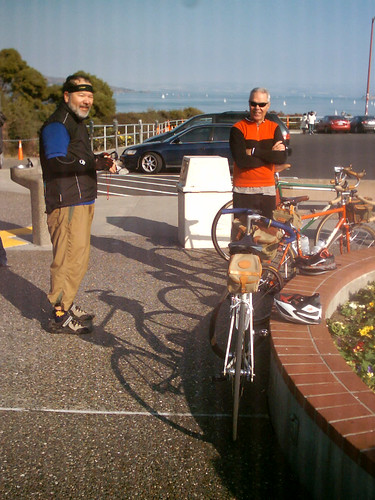
We dispersed shortly thereafter, JimM and I heading north (he had parked in the lot at the north end of the GG Bridge), and just as we picked up speed on the decline of the bridge, saw Ron, Tom, Michael and RexRider coming towards us. Hollering “hey”, we continued past one another. Definitely felt badly at getting separated, and I think I’ll need to work on being more specific about a meeti-up place, should we vector differently in the future.
Rolled homeward, and distracted myself from the “gee-I’ve-been-riding-a-while” feeling by snapping photos of the impressively high tide, large spherical objects, and the pending completion of the Lincoln Avenue bike-ped path tunnel. Just rolled into the 77’s on the computer when I turned into the driveway. First “real” longer ride in a while.
A huge thanks to Ron for kicking this often-talked-about idea into reality.
Decided to put a heavier layer of protection on my new Nigel Smythe & Sons Keven’s bag from Rivendell. The vid cam was lying around, so here ya go…
Waxing Canvas from Cyclofiend on Vimeo.
One of the blogs I really miss reading is Large Fella On a Bike - the journal by Scott Cutshall as he rode his way back to life. It’s still around, but Scott pulled the plug on it a while back. (And, he’s a steady twitterer, but it’s not the same…)
Anyway - there’s a quick slideshow over on the Bicycling Magazine site -
http://www.bicycling.com/bke/
which shows a progression in 8 quick photos of Scott from 1999 to today. Setting aside the whole “Eight Quick Steps” literary approach of Bicycling, it’s a stunning transformation. If I have the facts correct, it also is in the current print edition.
A couple o’ months back, I was stomping my way down to engineer a class in Sausalito and ended up pedaling the last few miles single-leggedly. (The initial post appeared here, and then I nattered more about it yonder.) Now, the fine folks down the peninsula at Ritchey Logic did address the problem quickly and effectively. It turned out that my initial left crank arm had been subject to a voluntary recall, as it had been built sub-spec (got one? ID yours with this handy Ritchey Design Voluntary Recall pdf ) They received the crank and had another one out to me within a scant few days. All good.
Well, yes and no.
Let me say a few things about the crankset. Because I really like the crankset, and it’s important to know that. They are light and have a comfortably narrow tread (“Q-Factor” AASHTA citation), use a 110mm BCD chainring and have generally done their work reasonably quietly and efficiently. But, dealing with these breaking has reminded me of a whole host of other memories and experiences concerning crankarms, their failures and the fact that manufacturers have really managed to go out of their way to complicate this part. For the most part, my frustration is with the general area of cranksets, a needlessly stormy sea in which these cranks just now happen to be swimming.
This whole discussion is multiplying and expanding in my brain right now - because the Ritchey cranks remind me of why I went with them in the beginning - replacing a reasonably high-zoot set which failed egregiously. I broke two of those. Or, more accurately, I had two sets catastrophically fail on me. That recollectioin got me thinking about the sheer number of chainrings that wore out on the mountain bike - especially during the El Nino years - ground what seemed to be too soon into nasty shark fin profiles, which reminded me of the grease-and-voodoo-incantations engaged in attempt to quiet the continually squawking but beyond elegantly beautiful Cook E2 cranks I had, and how those were horsetraded to switch over to the then-new Shimano XTR 4-bolt design, which had wonderfully meaty and long lasting chainrings. I loved that setup - until I priced replacement rings, which - I kid you not - were only a couple of movie and burrito nights difference in price from a new crankset with rings…!
I think what I really want is a set of steel cranks. But, I’m getting a bit ahead of myself.
It’s possible I have crankset issues. Didn’t really realize it until writing all these things out. I do hate to rant, but, dang it, there should be a simple solution for all of this stuff. It should work and be solid, hard to mung up, and not look like it was created by an art director. There should be an elegant solution. This should be available.
Man, it does seem that I’m all worked up over this. But, I don’t think I should have to buy a 10 year old set of cranks to solve this problem. Again, I digress. Back to the story.
The replacement arm arrived from Ritchey and was a “B” fit. In other words, it was tighter than what I sent back to them, and I had to really press it to set it onto the splined interface of the bottom bracket. These cranks - the Ritchey Cross Cranks (which curiously do not appear any longer on the RitcheyLogic.com website) use an “Octalink” design which Shimano brought forth to sunset the square taper design which was simple and proven, but non-proprietary. On the Octalink, the 8 splines should mesh like gears and prevent the crank from rotating on the bottom bracket spindle. Unlike a square taper, it should not really be a force fit.
I lined them up carefully, pushed them on as tightly as I could, then tightened the new arm down, then removed the bolt again to make sure it had seated correctly. Took a couple of short, post-flu rides on the bike and from about the middle half of the first ride, something felt funny on my left hip and low back. Then it would get better, then it would appear again. As I was negotiating some slow speed maneuvers, coasting with the cranks level, there was a definite shift in the left crank arm. Flipping to the other foot forward, I felt it again.
Got home, broke out the good camera and took an image of the worst of it. Digital straight-edge added for reference: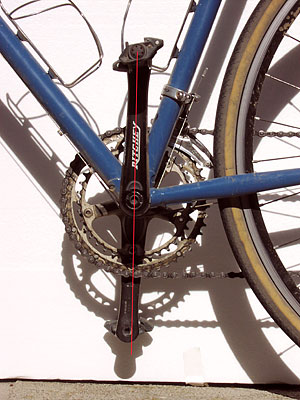
click for bigger than is really necessary.
The image is slightly misleading, as I used the non-drive crank arm as the reference. The drive-side arm is really the one that didn’t move. I could bring the arms in and out of alignment by leveling the cranks and weighting the left - forward equaled out, and back equaled in alignment. After sending this image to Ritchey, they wanted the arm back to see what was wrong. I did so and the day they received it, sent back a detailed email saying that the splines had been misaligned upon installation and that was what allowed the shifting. They also said they’d replace the arm so I could try again.
That was darned nice of them to do that. Honestly, I didn’t agree with their assessment. But, there’s certainly a possibility that my ham-fists and incrementally increasing farsightedness combined to do that. I’ve bent bits, snapped bolts and generally mucked up mechanical adjustments. Just didn’t think I did then.
Now, I did have an unplayed card had they chosen not to replace the replacement. Y’see, this is actually the second time this has happened. The first set I got of these had a similar issue, and as seen here the angle was more dramatic, but I rode more miles before becoming convinced there was an issue - 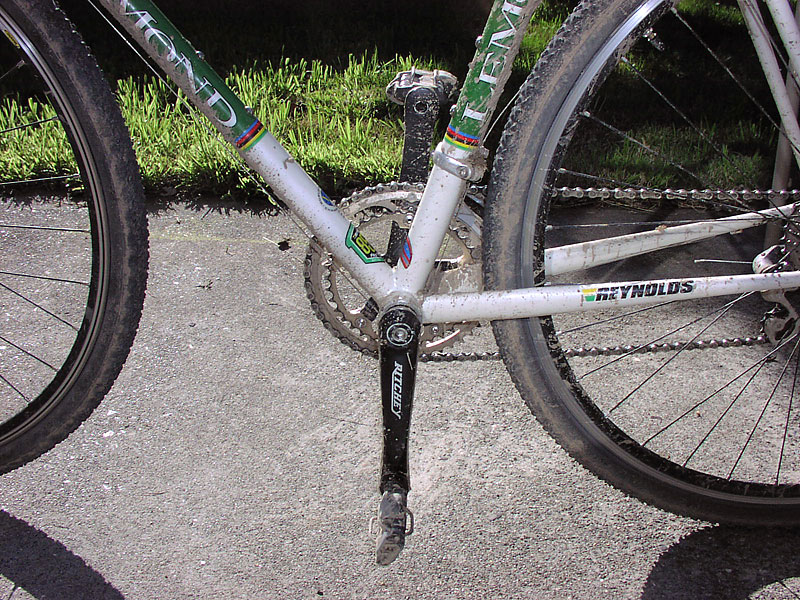
In this instance, Ritchey had dealt very kindly with the situation. The first arm had actually stripped out, and this was the replacement set. They replaced this as well, with the crankarm which ended up snapping. In the case of this arm, it had set easily upon the splines, so there really wasn’t an installation issue. My eyes were better back then, too.
Back to the Future - well, the future of a couple weeks or so ago. The 2nd replacement arm that Ritchey sent fit more easily onto the spindle. Just to make sure, I used the camera to make sure that things lined up before tightening everything down. 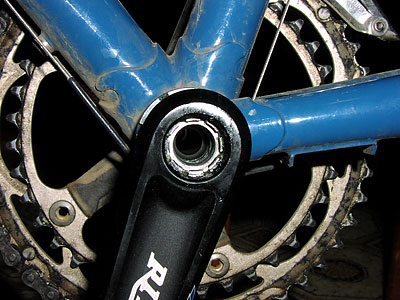
click for bigger than is really necessary, but it does give good detail.
I tried to be extremely mindful about the installation. Got it set into place, checked and double checked and even looked at the photo image onscreen before I put the bolt in and turned it tight.
And that’s pretty much the moment when I thought, “y’know, I really shouldn’t have to go through this to hang a phuh-reakin’ crankarm on my bicycle…”
It got me thinking that small splines are always fiddly little bits, and square tapers are stout simple means to install something. It’s actually easy enough to mount an Octalink crank one spline tooth off, so that the arms end up misaligned. You certainly (well, you certainly should) notice it before you get on and pedal, but it’s darned near impossible to not notice the 90 degree aberration if you did that on a square taper bottom bracket.
In other words, why did Shimano - or any of the manufacturer’s who signed on for the non-compatible ISIS version that came out around the same time - feel it necessary to take a simple working standard and change it?
I expect the answer might have had something to do with CNC-machining, and the boom of the mountain bike market. In the early 90’s, it seemed that anyone with an expired military contract and a machine shop was cranking out bike parts. Cranks were particularly sexy - highly visible, easy to make, easy to make unique looking. Just going to the BikePro crank overview gives 20 or so different manufacturers. My paper catalog shows about 18 pages of cranks, from companies like Kooka, Grove Innovations, Adventure Components, Flite Control, Grafton, Sampson, T-Gear, Sims and TNT. A goodly number of names that surfaced then and have since submerged.
Thing is, groovy-cool CNC’ing from raw billet can lead to some pretty dramatic failures, especially when the raw billet gets swaged onto a tapered connection and then really cranked down. Well made cranks are generally cold-forged, which means that you have to spend the money to make dies and such, but you align the grain of the metal in specific ways, to offset stresses from things like, oh, attaching them to the a tapered spindle and then torquing the heck out of them by pressing the pedals.
My recollection was that the ISIS standard and the Octalink standard came out at the same time, but I’m not sure that’s entirely correct. Maybe what happened was that Shimano wanted to regain the crank business - because at that time, they were really losing ground to non-Shimano cranks (and generally, across the board, on brakes, levers, etc.) - and so unveiled this new design of bottom bracket to make sure people used their cranks. The ISIS may have been a reaction to gain the claimed benefits to the newer BB design - since the larger, hollow spindle was supposed to be - wait for it - stiffer and lighter (lordy, how many times do we need to hear that?). But, I have to believe that setting a CNC’d crank arm into a fitted interface reduced the stresses from installation.
Which is why, some 10 years later, I’m looking at my computer monitor with a magnified image of a greasy splined interface, knowing that I have it lined up properly, but still making sure that I’m removing any variable that could be claimed as my incompetence.
At this point, a couple of rides later, things continue to work as they should. But, I really have not stressed things. In fact, my working plan is to have another moderate ride or two, then remove the arm and check the splines for galling.
That working plan got me thinking about cranks which are actually made these days, because at some point, I’m going to get tired of messing around with this thing, or Ritchey is going to run out of replacement arms for me.
Sugino is the the logical first visit. They have the XD2 which was the original crank on the Hilsen (shown below), and was used on the Quickbeam as well. It’s a very good value for the money, cold forged, silver uses a square taper. There are probably only two things that fall into the negative column for me - they are a hair wider than they need to be (Q-Factor/Tread):
As a non-scale comparison, here’s the same view of an totally different crank on an entirely different bicycle: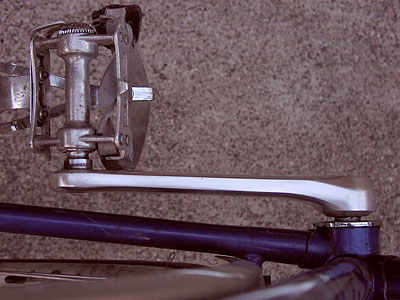
This image was taken of the Dawes, which has narrower rear triangle spacing (hence a slightly straighter angle of the chainstay) and uses an older Shimano 600 series (last year before they renamed it “Ultegra”) road crank.
To inaccurately illustrate the difference, I hand-positioned my XD2 non-drive arm in roughly the appropriate position while balancing the bike and snapping this photo with my other hand: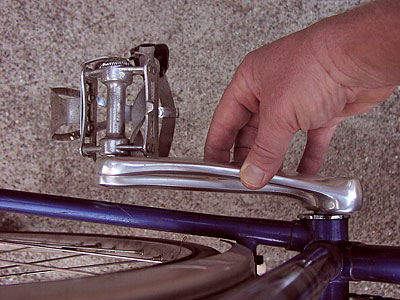
You can at least get a sense that the new/current design will sit further away from the chainstay - necessary if you are designing a crank for more current, shorter wheelbase bicycles which tend to have wider stays. And, I have shown a complete inability to be hampered by slight changes in this area. Some riders may be more directly impacted by it. I get on a wider set of cranks, go “whoa! those are wide!” and then promptly forget about it within the next half hour of riding.
The Sugino XD2’s also use the evil hidden bolt arrangement. The EHB arrangement is peculiar to triple chainring cranks, I think. The first time I came across it was with the Specialized crank (Strongarm? Son of Strongarm? I’m pretty sure it’s out there someone in the parts pile…) that came on my old M2 Stumpjumper. The outer two rings are held on with a standard “sandwich” of outer ring / machined spacer on the crankarms / inner ring. The fifth bolt position is in line with the crankarm itself. At this position, they machined a small gap so that you can fit the threaded nut into position. (I don’t have an image of this detail right now. You’d think, with all the pictures I’ve taken….)
What you end up with is a gap that is a bit too narrow for the chainring bolt tool to get in there. Which means you’ve got to figure out some combination of tools and angles to keep the threaded bit from turning as you torque down the bolt. With the Specialized design, I used to have to shove a rag and screwdriver tip in there. It’s a minor inconvenience, and I seem to overcome the issue. It just always gets me frowning when dealing with it. It seems really slick to integrate the 5th bolt to the arm itself, but just doesn’t work for me.
(As a comparison, the Ritchey Cross Cranks I have use the same hidden 5th bolt design, but just threaded the hole so you use a standard length bolt and go for it. I’ve never had the threading fail, but have had one of those bolts back out on me.)
One design I like is the Sugino Alpina 2 
Simple, silver, 5 exposed bolt design, but with the clever addition of material as “webbing” near the arm itself, presumably to distribute stresses effectively. What Sugino doesn’t indicate is whether or not they have a similar tread width to the XD2’s. Unfortunately, the website doesn’t have anything other than a side view. It’s only possible to guess from the images. There are a few vendors which list the Alpina (or Cospea) which appears to be more expensive. The only domestic “for sale” listing of the Alpina2 had it at ~$125 (significantly less than the Alpina/Cospea), but also says this isn’t available.
Poking around their website again, it appears that Sugino has also added a “Mighty Tour” to their lineup. Hard to say what the differences may be - it does seem to have sharper finishing and may be an actual replacement for the coveted Alpina/Cospea. But, it also seems that sometimes models surface on the Sugino site which don’t migrate into production models.
Returning again to the larger picture, a few years ago, Shimano came up withe the Hollowtech II series, which featured an outboard bearing design and “two-piece” crankset. Basically, this let them run an even larger spindle, which they permanently attached to the right crank arm. The left arm was then attached to the other end (using smaller teeth on the spindle, but wisely using a wider alignment notch which prevented misalignment. The outboard bearing design meant that all of a sudden, facing the bottom bracket of the bicycle frame became important again. It also meant that the chainline gets adjusted by using spacers between the bearings and the frame. You aren’t going to be able to tweak the position of the front chainrings by a few millimeters by getting a shorter bottom bracket spindle.
And, I’m not against this design precisely. Initially, there were a few simple designs, but everyone now seems to be phasing those out in favor of carbon. SRAM, for example, initially brought out a Rival series crank which was silver and looked pretty darned nice and allowed the use of a smaller inner chainring due to the 110BCD. Which of course meant that that they had to change the design, going to a black anodized finish and electing to use a 130BCD (minimim small chainring size of 38T). If silver was the only concern, you can still find their “Cross” crank model around (or the indistinguishable S300 GXP), but again, you are back to using the “road” rings of 130BCD. Everything else in the upper end is a carbon crank.
Which is really off the table for me, as the cranks which I alluded to way back at the beginning of this saga - the ones which failed twice on me - were carbon. More precisely, they were carbon wrapped over an aluminum skeleton. Light and stiff and all carbony, they both failed the same way, going from perfectly fine to “that feels funny” to rubbery, bendy, twist-em-with-your-hand delaminatedness within 15 minutes. Had it not been for the aluminum bones, they would have been useless. As it was, I was lucky enough both times to be relatively close to home.
I know why they failed - it’s simple enough. The resins had not permeated all the layers of carbon - clearly a manufacturing issue. The company (which curiously enough then got out of the crankset business entirely) replaced both pair after each failure, but I never used the third replacement - sold ‘em off (with full disclosure) to someone for whom carbon held a compelling allure and bought the Ritchey Cross cranks.
The companies who are still making carbon cranks have certainly had more than a few manufacturing cycles to shake down their processes. My guess is that they have more weight in resin than they do in carbon, and cranks are probably a reasonable application for the material, as impacts tend to be few, and you can, theoretically make the highest use of the directional nature of carbon. If you are going to hang carbon on your bicycle, it probably makes sense to put it there.
I just don’t really want them on my bike. Or maybe it’s just that I’d like to have a little more choice. Carbon just strikes me more and more like a disposable material. Maybe it’s aesthetics. For me, carbon starts shiny and sleek, but gets ratty when it ages, while to my eye the metals gain a burnished and rubbed finish as the years go by.
When looking back to aluminum, I have to admit that two aluminum crankarms failed on me as well. One was pretty danged old, failed exactly as aluminum tends to - minor warning cracks (which I did not notice), followed by immediate separation. That was the most dangerous example, as I went down reasonably quickly with vehicular traffic behind me. The other was sub-spec material, as I’ve rehashed to death at this point.
All of that strangely points me back to steel. On a set of cranks. Which is about as common in the current market as…well… a set of steel cranks.
What it could let you do, is work with some of the newer, lighter steels, have something which takes impacts well, fails in a slow manner and could look really nice. The only downside would be that they require plating for that snazzy shiny silver look that aluminum does so well. As I poked around the inerwebs, muttering about this and the kids on my lawn, I came across something that fit the bill - 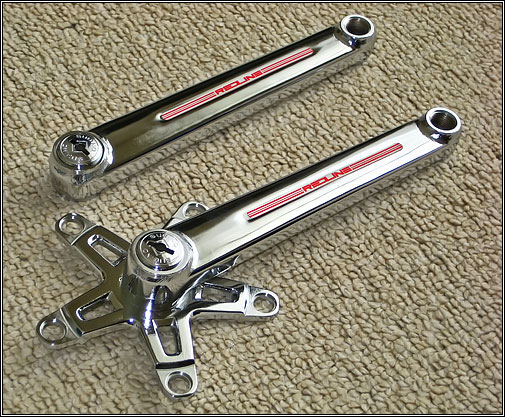
I found this image on Greg Terzian’s blog, with some really interesting historical information. First, these “Redline” Flight cranks were made by…Sugino. Second, as Greg states, “the Sugino 400 drive arm had a 110BCD five-bolt aluminum spider permanently installed.” And, the sharp-eyed among you have already noticed, it’s designed for a traditional square-taper bottom bracket. As his writings mention, these are of course highly coveted by collectors, who probably wouldn’t think of slapping ‘em on a bike and actually using them.
But, if I had some, I’d run ‘em…
A nice solid month, aided by the helpful holiday (snuck in an extra 45 mile ride which would have been difficult on a work day…), better health and ridiculously nice weather.
Ended up riding 21 days and covering 468 miles this month, mostly on the Quickbeam. (Do fixed miles count extra?), Managed steady commute mileage and a nice steady chunk of 40+ mile rides. Actually began to feel good now and again, found myself seatedly climbing up pitches that had been tongue-waggers at the beginning of November. Managed 7 sessions of yoga (no class on Thanksgiving…) and didn’t run at all. The last item doesn’t really bother me, as it’s pretty clear that this year’s CX campaign is minimal at best. Ahhh well, happens that way sometimes. The first SFR 200K is less than 60 days away…
Got the Dawes running again, which it deserved. Stately and simple.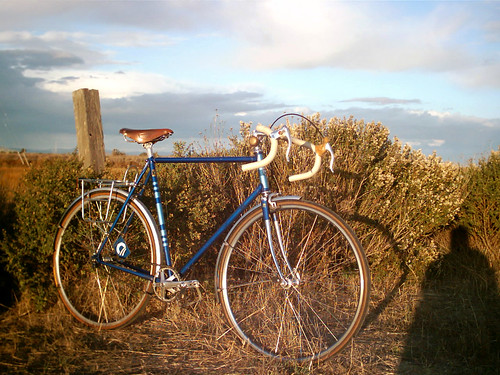
Any month that ends with the ceremonial removal of a worn out Pasela has got to be good. This one had moved back and forth between the Quickbeam and the Hilsen, where it ended its days. I thought maybe I’d scraped through there due to skidding (traffic related… I do not skid-stop, or skip-stop or anything like that). But, after removing it, there were numerous other “show-throughs”. The tire felt paper thin in the center. I do love wearing bits out… 
Sometimes, I get a little edgy this time of year, as the nights lengthen and sunlight seems tenuous at best. But, so far, there hasn’t been that holding-on-until-the-Solstice feeling, whether aided by lunchtime loops, the feeling of good things coming together or the aforementioned ridiculously glorious weather. Three more weeks until the Solstice, and then the days start getting longer again.
